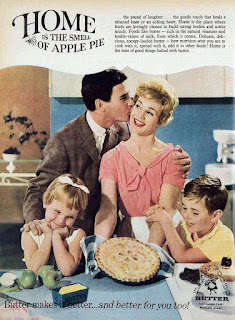When I first came to Germany and listened to people in group discussions talking about advertising (mostly TV advertising in those days), one phrase I heard again and again was Heile Welt. It’s a phrase that doesn’t translate exactly into English, but the idea is of an undamaged/unhurt/unbroken world. It’s a bit like a Utopia, but presented as if it just could be reality.
Advertising in those days in Germany was more influenced by US-style advertising typified by P&G than the more self-deprecating humour, or surreal flights of fantasy found in UK advertising at the time.
The Heile Welt had some typical tropes - flawless skin, happy nuclear families, white washing and sparkling homes, svelte and beautiful career women tossing manes of glossy hair around, endless summers in a countryside idyll, wise and knowing loving grannies in cosy rustic kitchens, square-jawed men driving impossibly shiny cars up picturesque mountain passes ... R.E.M’s Shiny Happy People wherever you looked.
I think, in those days, most people watching knew the rules of the game. It was only advertising, after all.
In the last few years, there has been a greater call for authenticity in brand communication. More reflection of “real people” (what other kind are there?) and “real life” as well as more representation of today’s diverse society.
But have we exchanged one Heile Welt for another?
I suspect, looking at this year’s selection of Christmas ads, that we have.
Advertising has moved from material or appearance-related aspiration to what I’d call emotional aspiration.
People in ads these days - from tiny tots to great-grandparents - are caring and generous. Inclusive, tolerant and kind. Feisty and resilient. Empathetic and compassionate.
But I can bet you that these models of new EQ standards make some people feel as inadequate as the impossibly slender models of the last century’s beauty standards (by the way, I’ve always wondered if there's some ministry hidden away somewhere busily setting all these standards that the new advertising is so keen to disrupt and smash).
This kind of advertising is no more “authentic” than the stuff from the last Heile Welt. Real homes are messy, and so are real people, emotionally. On a good day, I can be a model of empathy and compassion, but on other days I can be downright spiteful and pig-headed. It’s called being human.
I don’t mind a bit of emotional depth in advertising, but I’d ask agencies to be more honest - or even authentic - about what they’re producing.
Good story-telling that pulls at the heartstrings is nothing to be ashamed of - but just don’t pretend that it’s real life.








No comments:
Post a Comment